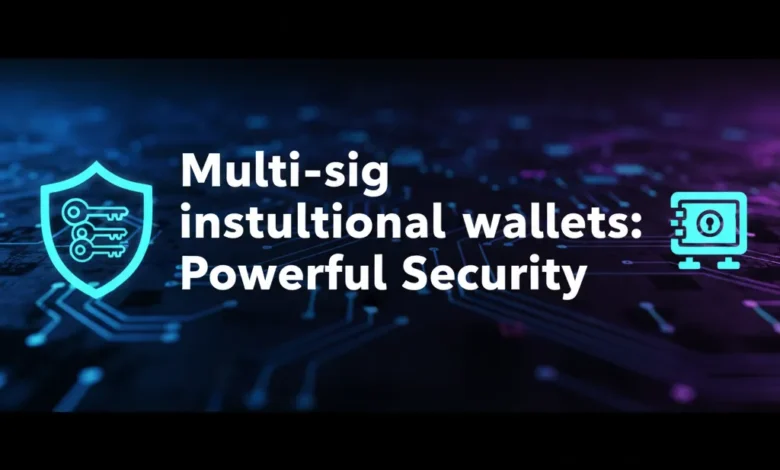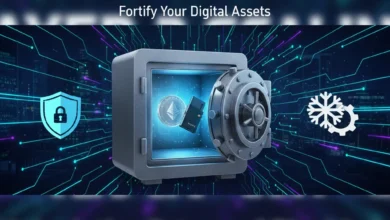
Multi-sig institutional wallets: Powerful Security, Secure institutional crypto assets with multi-signature wallets. Explore enhanced security, control, and risk, multi-sig institutional wallets: Powerful Security, Secure institutional crypto assets with multi-signature wallets. Explore enhanced security, control, together with risk, safeguarding valuable holdings against unauthorized access together with internal threats, a critical consideration for institutions navigating the complex world of digital finance.
Multi-sig institutional wallets: A Deep Dive
The world of digital assets presents unique challenges for institutions seeking to participate. Traditional financial security measures often fall short when applied to cryptocurrency together with other blockchain-based assets. This is where multi-signature (multi-sig) wallets become essential. Multi-sig institutional wallets require multiple authorized signatures to execute a transaction, greatly reducing the risk of single points of failure together with internal collusion. They represent a cornerstone of robust cryptocurrency custody solutions.
Understanding the Core Principles of Multi-Sig
The fundamental concept behind multi-sig is simple: instead of a single private key controlling access to funds, multiple keys are required. Each key holder acts as a co-signer, together with a predefined threshold of signatures is necessary to authorize a transaction. For example, a “2-of-3” multi-sig wallet requires any two out of three designated key holders to approve a transaction. This distributes control together with prevents a single compromised key from resulting in asset loss. This distributed control is a vital feature of enterprise crypto security. The number of required signatures together with the total number of possible signers can be tailored to fit the institution’s specific risk profile together with governance structure.
Benefits of Multi-Sig for Institutional Crypto Custody
The advantages of multi-sig institutional wallets are numerous, particularly for organizations managing substantial digital asset holdings. Firstly, it significantly reduces the risk of internal fraud together with theft. No single individual can unilaterally move funds. Secondly, it provides resilience against key loss else compromise. suppose one key is lost, the other keys can still be used to recover the assets. Thirdly, it enhances operational efficiency by allowing for delegation of signing authority. Different departments else individuals can be assigned specific signing roles based on their responsibilities. Finally, multi-sig supports robust governance together with compliance frameworks, as transaction approvals can be tied to predefined policies together with procedures.
Choosing the Right Multi-Sig fix
Selecting the appropriate multi-sig fix involves careful consideration of several factors. The chosen fix should integrate seamlessly with existing infrastructure together with workflows. Scalability is crucial; the fix should be able to accommodate future growth in transaction volume together with asset holdings. The user interface should be intuitive together with uncomplicated to utilize, minimizing the risk of human error. Crucially, the fix’s security architecture should be thoroughly vetted together with independently audited. Consider solutions that offer features like hardware security module (HSM) integration for enhanced key protection.
Key Management Strategies for Institutions
Effective key management is paramount for the security of multi-sig institutional wallets. Keys should be generated using mighty cryptographic methods together with stored securely, ideally in cold storage. Cold storage solutions involve storing keys offline, disconnected from the internet, significantly reducing the attack surface. Hardware security modules (HSMs) provide a tamper-proof environment for key generation together with storage. Regular audits of key management practices are essential to identify together with address potential vulnerabilities. Implementing mighty access controls together with role-based permissions ensures that only authorized personnel have access to keys. Backup together with recovery procedures should be in place to mitigate the risk of key loss else damage. Cryptocurrency custody solutions are often built with these elements in mind.
Integrating Multi-Sig with Existing Security Frameworks
Multi-sig should not be viewed as a standalone security measure however rather as an integral part of a broader security framework. It should be integrated with existing identity together with access management (IAM) systems, intrusion detection systems (IDS), together with security knowledge together with event management (SIEM) systems. This allows for centralized monitoring together with management of security events across the entire organization. Regular penetration testing together with vulnerability assessments should be conducted to identify together with address potential weaknesses in the overall security architecture. A well-defined incident response plan is crucial to address security breaches promptly together with effectively. These measures contribute to a more robust enterprise crypto security posture.
Addressing the Challenges of Multi-Sig Implementation
While multi-sig offers significant security benefits, it also presents certain challenges. One challenge is the increased complexity of transaction processing. Approving transactions requires coordination among multiple key holders, which can be time-consuming together with cumbersome. Another challenge is the potential for disputes among key holders. Clear governance policies together with procedures are essential to resolve disagreements together with prevent transaction delays. Furthermore, the cost of implementing together with maintaining a multi-sig fix can be significant, particularly for organizations with complex security requirements. Addressing these challenges requires careful planning, implementation, together with ongoing management.
Emerging Technologies together with Innovations in Multi-Sig
The field of multi-sig apparatus is constantly evolving, with new innovations emerging to address existing challenges together with enhance security. One promising development is the utilize of multi-party computation (MPC) to enable multi-sig functionality without revealing the individual private keys to each other. MPC allows for the secure computation of transaction signatures without compromising key secrecy. Another innovation is the development of more sophisticated key management solutions that automate key rotation together with backup procedures. Furthermore, advancements in blockchain apparatus are enabling the creation of more flexible together with programmable multi-sig wallets that can be customized to meet specific institutional requirements. These advancements contribute to the ongoing improvement of Secure digital asset management practices.
Best Practices for Securing Multi-Sig Institutional Wallets
To maximize the benefits of multi-sig institutional wallets, it is essential to follow best practices. Conduct regular security audits together with penetration tests. Implement mighty access controls together with role-based permissions. Educate employees about security risks together with best practices. Monitor transaction work for suspicious patterns. Keep software together with hardware up to date with the latest security patches. Regularly review together with update security policies together with procedures. By adhering to these best practices, institutions can significantly diminish their risk exposure together with protect their digital assets. Employing these tips increases overall wallet security.
The Future of Multi-Sig in Institutional Finance
Multi-sig institutional wallets are poised to play an increasingly significant role in the future of institutional finance. As digital assets become more mainstream, institutions will require robust together with secure cryptocurrency custody solutions to manage their holdings. Multi-sig offers a proven together with effective way to mitigate security risks together with ensure the safety of digital assets. Ongoing innovation in multi-sig apparatus will further enhance its capabilities together with make it more accessible to a wider range of institutions. As the regulatory landscape for digital assets evolves, multi-sig is likely to become a mandatory requirement for institutions holding cryptocurrency. Institutional grade wallet apparatus will continue to advance alongside the growing demand for digital asset security.
Multi-sig institutional wallets represent a critical component of a comprehensive security strategy for any institution engaging with digital assets. By understanding the principles of multi-sig, carefully selecting the right fix, together with implementing robust key management practices, institutions can significantly diminish their risk exposure together with protect their valuable assets. Embrace the proactive approach offered by multi-sig, integrate it with your existing security framework, together with remain vigilant about emerging threats to secure your digital future. Prioritizing the security of your Digital assets is paramount for long-term success in the evolving landscape of institutional finance.




